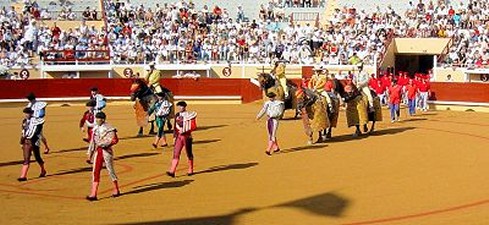
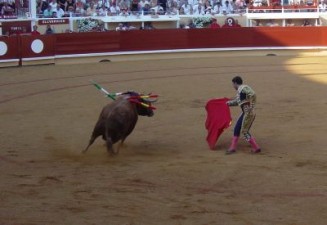
CORRIDA: is the overall name for an evenings event in the Arena, this consists of 3 Matadors completing 2 tournaments (2 Bulls each), each lasting approximately 20 minutes.
TORO: is the name for a Bull in Spanish and in a Corrida he must be over 4 years old.
The first out with the Bull is the Matador with just a large red cape (called a "Cape", surprise, surprise!!), to test the power and the charge of the animal, this lasts for approximately 3 - 5 minutes.
Next after the sound of several horns (Trumpets), the "Picador" arrives, this is the name for the man on a protected horse, his job with the long lance (la Pique) is to puncture the large muscle at the rear of the 600 kilo Bulls neck. To stop the Bull from lifting his head to high when bucking or charging. He would normally have to do this a minimum of 2 times but for a big strong animal perhaps 1 other.
Next more horns, now it's the turn of the "Banderilleros" to plant 2 x 600mm (2ft long) short spears (Banderilles) simultaneously into the back of the Bulls neck, this is completed 3 times (6 Banderilles in total), this takes some courage and very good accuracy with a very heavy charging Bull, this is to try to slow the animal down and tire him out.
Next after the sound of several more horns, Last, but definitely not least, the hero, the Matador or Toreador as he is known in different parts of Spain & South America, commences to play with the Bull, showing the animal the smaller red cape (la "Muleta", which is now disguising the sword) and encouraging it to charge, showing no fear and with as much skill, panache, machoism as he can muster to keep the attention of the crowd in the arena. The Matador slowly wears the Bull down, tiring him out and with one skillful thrust of his sword (known as "l'Estocade") in a very small area at the back of the head, kills the Bull with an attitude of dignity for the mighty animal.
If the Picador, Banderilleros & Matador show their skill magnificently the
crowd go wild, but if they don't, especially if the Matador does not put the
Bull down in one thrust (l'Estocade) with the sword (he has another turn to
finish the Bull, but this time he uses a large dagger) and also fails with
the second attempt or it all takes to long, the crowd show their displeasure
and the Matador looses allot of members of his fan club.
Or on the contrary, if the Matador does well or extremely well, the
spectators show their appreciation by clapping and shouting Bravo this is
normal. If he has shown exceptional courage and skill, the crowd will wave
white handkerchiefs to indicate to the President of the Corrida, that in
their opinion the Matador deserves an honor. If the honor is to be given,
this is shown by the President indicating to the arena marshal & adjudicator
(the name is "Alguacile") by placing a large white handkerchief on the
balcony in front of him, to cut off 1 ear of the Bull, if the crowd continue
and the president also concludes that the Matador has done well, he places
another (this indicates 2 ears) and the greatest Honor of all is the third
white handkerchief, to cut off the tail of the animal.
The final epitaph to the Bull is that he is taken away and sold by the kilo in all the local butchers in the town.
Note: Not all Matadors walk away, some are injured, some are badly mutilated and some have been killed by the Bull.
Ernest Hemmingway the famous writer was an avid Corrida fan, each year he took part in the equally famous Fete & Corrida in Pamplona Northern Spain. Now the road adjacent to the Arena has been named "calle de Ernest Hemmingway" and a statue of this famous fan, stands at the entrance to the Arena where the street Bull run enters, as if he continues to watch and admire.
Corrida Equestre (Spanish Bull Fighting, all on horse back)
The same explanation as above applies here, but not just with the Picador on horse back, Banderilleros & Matador as well.
Corrida (Portuguese)
A simalar explanation to the above applies here to, but all done without the killing of the
animal and to keep the attention of the spectators a little bit more a
spectacular and flamboyant.
Novillada sans (without) Picador
A same explanation as the above applies here to, but the Matador is an apprentice and the rest are experienced, but not
necessary for a Picador as the Bull is so young. The Bull must be under 3
years old, which means he is a lot smaller and weighs less.
Novillada Piquee
A same explanation as the above applies here to,
but the Matador is a mature apprentice and with more experience and the use
of a Picador is re-instated. The Bull must be under 4 years old, which means
he is larger than that used for "Novillada sans Picador", but smaller than
that used for Corrida.
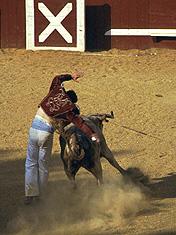
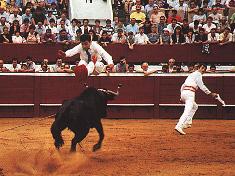
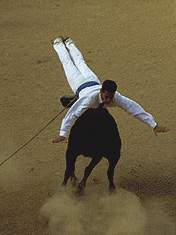
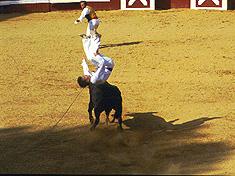
photos ©Jean Philippe Plantey
Course Landaise is an ancient popular game of the Aquitaine Region, which has now become an official sport in France.
Like all arena games, the Course Landaise has a fundamental principle: The opposition of 2 forces, between the intelligence and agile skill of Man and the strength, agility and aggression of the Cow and that's it.
Lets make one thing very clear at this point: There
are no weapons or red cloaks used on the animals. The Cow does NOT DIE.
All there is between Man and Beast in the Course Landaise is skill,
acrobatics, gymnastics and a rope (explained later).
The Cows, named "Landaise", have taken part in the games over many years, other types of Cows and Bulls have been tried, but none have lasted the test of time for agility and entertainment as the Landaise, so that is why the sport is known today as "Courses de Vaches Landaises".
To explain "Vaches" for those of you not conversant with French: Vache is the name for a Cow (in English) but these are totally different to the domestic types found in the farm yard, they were originally a wild prairie version that roamed the plains of Spain and the same type of breed as the Toro (Bull) used in Spanish Corridas (Bull Fights). This type of Cow is now bred in the Landes Departement of France especially for this purpose. They are not reared for eating and they don't produce milk (So do not think there are a lot of Cows with udders charging around an Arena, because there's not). The difference in size between the "Vache" and "Toro" is best described by weight, the "Vache" is around 250/300 kilos (550/660 lbs), very quick and agile and the "Toro" around 575/625 kilos (1265/1375 lbs), not as agile, but once on the move he is just like a Chiefton army tank, unstopable.
The Sport consists of provoking the animal into charging.
For the man to
wait as long as possible and then to move away at the last possible moment
by any means available to him, but all applied with as much gusto and
machoism as possible.
The Moves
The "Ecart" (Swerve): The man known as an "Ecarteur" in the Arena, waits and taunts the animal with raised arms. When the charging Cow is only a few meters from him, he makes a vertical jump (he hopes he judges the situation correctly) and lands close to the muzzle & horns of the Cow and then quickly swerves to make the Cow pass behind his arched back.
The "Ecart Feinte" (Dummy): The "Ecarteur" waits, still and with arms folded. With a slight movement of the head, indicates to the Cow that he is going to turn in that direction and when the Cow is charging, the man turns the opposite direction (he hopes, just like many football goal keepers think they know which way a player is going to shoot a penalty and look at the mess they make of it and that's man estimating man?).
The "Saut" (Jump): When the Cow lowers her head to charge, the man this time known in the Arena as a "Sauteur" charges at the Cow by running and then jumping or somersaulting over the animal to end up behind it, which if it works, confuses the animal (first you see me now you don't type of thing, but this move can some times end up in an awful mess, imagine two cars hitting each other in a head on crash, now you have the picture! who's judging who with what personality?), baring in mind that the "Vache Landaise" does not die each time and are used over and over again, which means the animal also gains in experience as to what might happen next.
The Rope : All Arenas make it essential to put the Cow on a long charging line (with 1 or 2 strong men attached to the other end), so that in the event of a mishap, they can protect the man from the stomping feet of the animal or its dangerous horns.
We hope this has made the object of the games clearer, but if it hasn't, come and see for your self!
Text by Mr "Bob" Robert Talbot